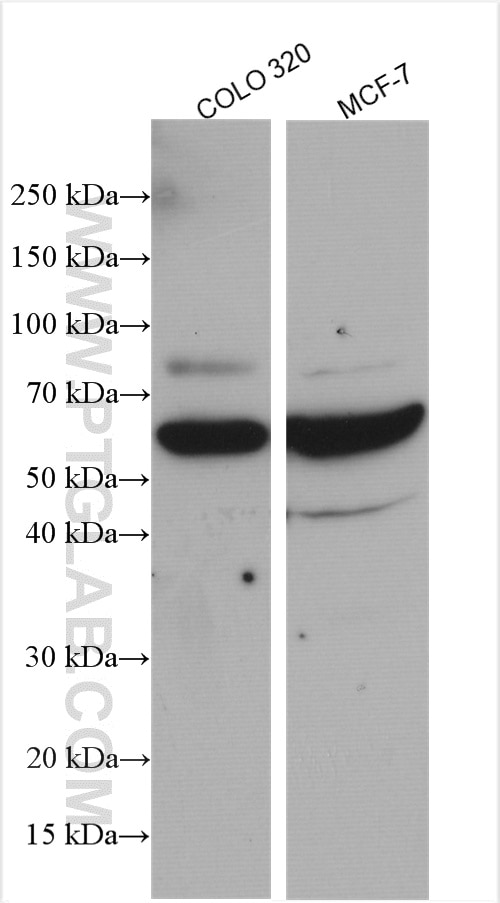- Phare
- Validé par KD/KO
Anticorps Polyclonal de lapin anti-YME1L1
YME1L1 Polyclonal Antibody for WB, IP, IF, ELISA
Hôte / Isotype
Lapin / IgG
Réactivité testée
Humain, rat, souris et plus (1)
Applications
WB, IHC, IF/ICC, IP, CoIP, ELISA
Conjugaison
Non conjugué
N° de cat : 11510-1-AP
Synonymes
Galerie de données de validation
Applications testées
| Résultats positifs en WB | cellules COLO 320, cellules HeLa, cellules MCF-7 |
| Résultats positifs en IP | cellules HeLa, |
| Résultats positifs en IF/ICC | cellules HepG2, |
Dilution recommandée
| Application | Dilution |
|---|---|
| Western Blot (WB) | WB : 1:500-1:2000 |
| Immunoprécipitation (IP) | IP : 0.5-4.0 ug for 1.0-3.0 mg of total protein lysate |
| Immunofluorescence (IF)/ICC | IF/ICC : 1:200-1:800 |
| It is recommended that this reagent should be titrated in each testing system to obtain optimal results. | |
| Sample-dependent, check data in validation data gallery | |
Applications publiées
| KD/KO | See 14 publications below |
| WB | See 61 publications below |
| IHC | See 1 publications below |
| IF | See 8 publications below |
| IP | See 2 publications below |
| CoIP | See 1 publications below |
Informations sur le produit
11510-1-AP cible YME1L1 dans les applications de WB, IHC, IF/ICC, IP, CoIP, ELISA et montre une réactivité avec des échantillons Humain, rat, souris
| Réactivité | Humain, rat, souris |
| Réactivité citée | rat, Humain, singe, souris |
| Hôte / Isotype | Lapin / IgG |
| Clonalité | Polyclonal |
| Type | Anticorps |
| Immunogène | YME1L1 Protéine recombinante Ag2069 |
| Nom complet | YME1-like 1 (S. cerevisiae) |
| Masse moléculaire calculée | 716 aa, 80 kDa |
| Poids moléculaire observé | 63 kDa |
| Numéro d’acquisition GenBank | BC023507 |
| Symbole du gène | YME1L1 |
| Identification du gène (NCBI) | 10730 |
| Conjugaison | Non conjugué |
| Forme | Liquide |
| Méthode de purification | Purification par affinité contre l'antigène |
| Tampon de stockage | PBS avec azoture de sodium à 0,02 % et glycérol à 50 % pH 7,3 |
| Conditions de stockage | Stocker à -20°C. Stable pendant un an après l'expédition. L'aliquotage n'est pas nécessaire pour le stockage à -20oC Les 20ul contiennent 0,1% de BSA. |
Informations générales
YME1L1(ATP-dependent zinc metalloprotease) is also named as FTSH1, YME1L,Meg-4,PAMP. YME1L1 plays a phylogenetically conserved role in mitochondrial protein metabolism.It also ensures cell proliferation, maintains normal cristae morphology and complex I respiration activity, promotes antiapoptotic activity and protects mitochondria from the accumulation of oxidatively damaged membrane proteins. YME1L1 can prevent mitochondrial DNA inserting into nuclear. It has 3 isoforms produced by alternative splicing with the molecular weight of 86 kDa, 80 kDa and 76 kDa. This protein can migrate with a molecular weight of about 55-63 kDa, which is the size of the mature YME1L1 protein(PMID:22252130; 22354088).
Protocole
| Product Specific Protocols | |
|---|---|
| WB protocol for YME1L1 antibody 11510-1-AP | Download protocol |
| IF protocol for YME1L1 antibody 11510-1-AP | Download protocol |
| IP protocol for YME1L1 antibody 11510-1-AP | Download protocol |
| Standard Protocols | |
|---|---|
| Click here to view our Standard Protocols |
Publications
| Species | Application | Title |
|---|---|---|
Cell Metab C9orf72 regulates energy homeostasis by stabilizing mitochondrial complex I assembly.
| ||
Nat Cell Biol MIROs and DRP1 drive mitochondrial-derived vesicle biogenesis and promote quality control.
| ||
Nat Cell Biol PARL mediates Smac proteolytic maturation in mitochondria to promote apoptosis. | ||
Mol Cell Identification of TMEM126A as OXA1L-interacting protein reveals cotranslational quality control in mitochondria | ||
Mol Cell Adaptive translational pausing is a hallmark of the cellular response to severe environmental stress. |
Avis
The reviews below have been submitted by verified Proteintech customers who received an incentive forproviding their feedback.
FH Christopher (Verified Customer) (03-08-2022) | incubated for 1 hour at RT. produced a weak signal at the expected molecular weight that was sensitive to a YME1L1 targeting sgRNA.
 |







